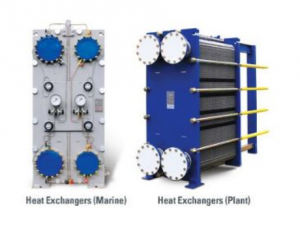DHP Engineering – Marine Heat Exchanger – Aqua Logistics Pte Ltd is the S.E.A. representative for DHP Engineering , based in Singapore, with extensive track records catering to various marine & offshore applications.
Principle
Plate heat exchangers have more than 100 years history and its structure is composed of a fixed frame, a movable frame and corrugated plates which are in between the two frames. Hot liquid and cold liquid go through between the corrugated plates in turn. To prevent leaking, gaskets are mounted around the plates and tightening bolts are used to put the plates together. There is heat transfer between the two liquids through the plates. This is the main principle of a plate heat exchanger. The arrangement of two liquids is that the cold liquid goes upward and hot liquid goes downward in order to increase heat transfer efficiency. There is an advantage to use plate type heat exchagners over Shell and Tube type heat exchangers, as the corrugations in the plates increase the liquid turbulence to a low Reynolds number and the liquids flow is counter flow so that the heat transfer efficiency is always 3-5 times higher than Shell & Tube type heat exchangers.
Design
The main components of the Plate Heat Exchangers
* The Plate pack comprises of a number of heat plates, according to the heat transfer surface required.
* Gaskets on the plates ensure that the fluid channels are securely sealed from each other.
* The direction of flow within the exchanger is determined by the gasket.
* The frame enclosing the plate pack is held together with tightening bolts.
* Connections for incoming and outgoing fluids are usually in the fixed frame of the heat exchanger
In the case of multi pass flow, connections have to be in the fixed frame and the movable frames.
Innovative Plate Technology
Newly Developed ‘Perfect seal’ Gasket
* Internatioanl Patent Right Registered(28 Countries)
* 3 Dimentional Pressure Dispersion System
* 300% Higher Friction Force(Up to 50 bar)
* Good keeping of Tightened Plate Pack
* Guarantee Longer Life Time of Gaskets
-Single Pass
As single pass has the counter flow and the nozzle is mounted on the fixed frame, only frame can be moved for maintenance so it is easy for the maintenance and increase or decrease in capacity.
-Single Pass & Multi Pass
If the temperature is much different between inlet and outlet and the allowable pressure loss between hot side and cold side is much different, the performance can be enhanced by increasing overall heat transfer coefficient, making one side to be 1 pass and the other side to be multi pass.
-Multi Pass
If the flow rate is quite less than heat transfer rate and the pollution level is not much, the advantage is that the heat transfer effect can be increased significantly by designing both hot side and cold side to be multi pass but the disadvantage is that the piping of nozzle part in the movable frame should be corrected when it is necessary to expand the heat exchanger capacity.
-Single & Multi-Multi Pass
This is an efficient heat exchanger that can make possible the heat exchange for more than 3 types of the fluid by one unit of the heat exchanger using a separator frame. It is mainly used for sterilizer in food industry.
Special Feature
-Cost savings
DHP plate Heat Exchangers save costs, with their high efficiency, low investment, compact installation and simple maintenance.
-High Heat Transfer Coefficients
DHP Plate Heat Exchangers provide high rates of heat transfer, due to the turbulence inducing shape of the plates. The special gasket configuration of the plates prevents any mixing of the media being processed. In the port area both fluids are separated by double gaskets. Additional safety is ensured by the leakage gap.
-Adhesive-Free Gasket
DHP developed adhesive-free gaskets. The optimum gasket setting in the gasket groove and the fixing of the gaskets by pressed indentations, allow high resistance against pressure and enable a quick and simple gasket replacement.
-Flexibility
DHP Plate Heat Exchangers can be adapted to changing process conditions. If process conditions change plates can be added or removed easily. This eliminates the need for costly re-investment.
-Low Product Content
This small volume of liquid in the Plate Heat Exchangers is the reason for the low weight of the equipment. It enables a faster start up and shut down of the complete plant, than conventional heat exchangers.
-Compact Design
DHP Plate Heat Exchangers are of compact design. For example, 200m2 of heat exchange surface require a Plate Heat Exchanger of onlyapprox. 3m length, 2m height and 1m width. For a shell and tube heat exchanger to achieve the same duty, about 600m2 of heat exchange surface would be required.
-Reliable Gasket Structure
DHP’s new development of ‘Double Seal’ gasket system overcomes the limitaion of ordinary plate heat exchanger.(3 times high-pressure endurance).
Official Website: www.dhpeng.com



